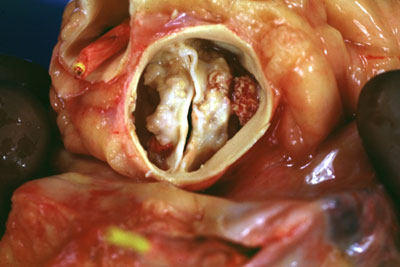Calcified Aortic Valve Stenosis – What Is It?
By Adam Pick on September 10, 2008
According to reports, aortic valve stenosis is relatively common problem effecting 2% of people over the age of 65, 3% of people over the age of 75, and 4% of people over the age of 85. One of the major causes of stenosis is the calcification of the aortic heart valve. This is especially likely to occur in people with a bicuspid aortic valve, but also occurs as a result of age-induced ‘wear and tear’.
Typically, aortic stenosis due to calcification of a bicuspid valve occurs in the fourth or fifth decade of life. Whereas, aortic stenosis — due to calcification — of a normal valve tends to occur in the seventh or eighth decade of life. To learn more about aortic stenosis, click here.

Of the various forms of aortic stenosis, the calcific type is predominant. Since calcific aortic stenosis shares many pathological features and risk factors with atherosclerosis, and since atherosclerosis may be prevented and/or reversed by cholesterol lowering, there has been interest in attempting to modify the course of calcific aortic stenosis by cholesterol lowering with statin drugs.
Although a number of small, observational studies demonstrated an association between lowered cholesterol and decreased progression, and even regression, of calcific aortic stenosis, a recent, large randomized clinical trial, published in 2005, failed to find any predictable effect of cholesterol lowering on calcific aortic stenosis. However, a 2007 study did demonstrate a slowing of aortic stenosis with the statin… rosuvastatin.
So you know, I suffered from calcified aortic valve stenosis as indicated above. When I reached the age of 33, my bicuspid aortic valve had become severely stenotic. While I was mostly asymptomatic, blood flow through my aortic valve was hindered and my heart had already begun to enlarge (dilate).
Luckily, I caught this severe heart valve disease just before permanent damage was done to my cardiac muscle. I’ll never forget what Dr. Vaughn Starnes said to me after my aortic valve replacement. Doctor Starnes said, “Adam – We caught this just in time. The valve was very calcified, very white, very sick!”
I hope that helps explain more about the impact of calcium deposits building up on the aortic valve.
Keep on tickin!
Adam
|
Cindy Tarver says on September 11th, 2008 at 3:56 pm |
|
And I would suppose the same sort of problem with calcified leaflets of the mitral valve, which is what I now have. I am also getting a review with Dr. Starnes at USC about my repair/replacement options. I have been told I could wait a year … but I’m thinking … this isn’t something that is going to go away or even improve if left for a year. And I don’t want the heart muscle to become any more enlarged than it is at this point. I pretty much have decided to have my surgery done ASAP after I hear from Dr. Adams in NY & Dr. Starnes in CA at USC. At age 55 replacement has been recommended so far, as the pig or cow valves are good for only 10 yrs. I don’t want to do this more than I absolutely have too!! |
 |
|
gabie says on June 23rd, 2009 at 8:36 am |
|
Hi, my sister underwent valve replacement surgury but once they opened her there was calcification and the surgeon closed her up and did nothing. |
 |
|
mohit says on December 21st, 2009 at 4:20 pm |
|
Hi Adam Good to know that your heart is still ticking :). I was diagnosed with aortic stenosis at age of 23 and had aortic valve replacement at that time. As such doctors did not find any cause of the calcification of my aeortic valve! Can you think of any reasons why aortic valve can become calcified? I am now 25 and as such all the studies online show that I can have another AVR in next 20 to 40 years. It would be good to know why my vavle deteriorated suddenly. Please rule out the following: Thaks |
 |
|
Ron says on July 13th, 2011 at 2:28 pm |
|
Your site is very informative, I appreciate the way it’s presented. I’ve had aortic stenosis my whole life, had my valve dilated surgically when I was a teen in the 80s, and looking at possible replacement at some point here. |
 |
|
georgie says on April 24th, 2012 at 9:41 pm |
|
I had an aortic valve replacement 4 yrs ago, it is stiffening up and I may have to have more surgery. I would like to have it done with a non-invasive procedure as I am now 86 and don’t feel I could go through another 6 wk recovery period – the first one was not easy. I have researched the TAVI/TAVR procedures and the time spent in the operating room and hospital is so much less. I don’t have a lot of the listed symptoms, but I do have some trouble when I exert myself; mostly going uphill or stairs. Hopefully I will know more the first part of June. Interesting to read other people’s experiences. Mostly I would like to know how this calcification happens, is it dietary? not enough fluids? etc.? |
 |












